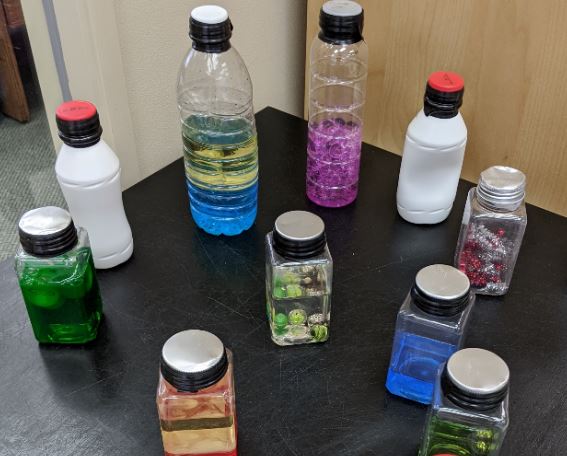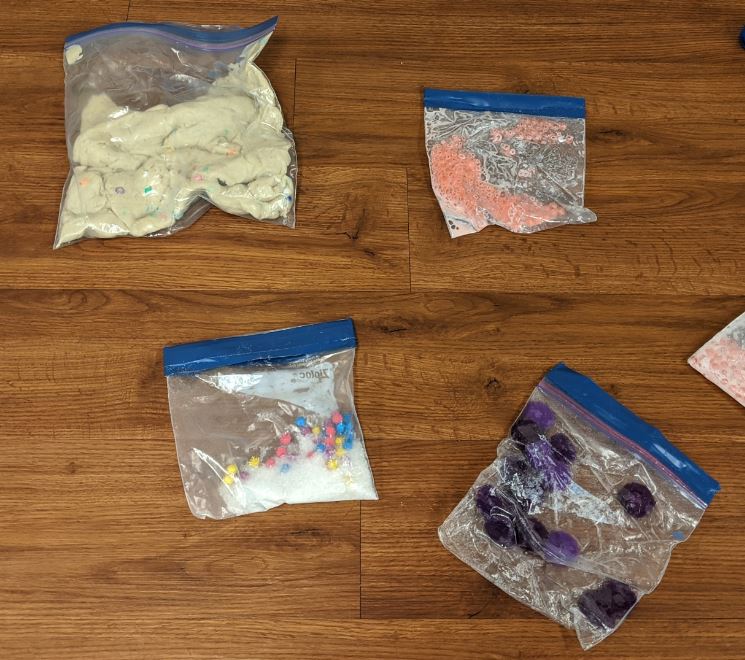Sensory Bottles and Bags—Ideal for Individual Sensory Exploration
Written by Julie Bisnath, BSW, RSW
Preparing to embrace and move forward with a new sense of “normal” provides a perfect opportunity to reflect upon and be creative when selecting toys and other items for play. While the more traditional type of sensory play (small open bins of material with groups of children exploring together) is currently being discouraged, individual sensory exploration can and should be included as an option for all children.
Sensory bottles and bags provide young children with the opportunity to enjoy a variety of sensory experiences without the mess, shared contamination, or potential mouthing/choking hazards of an open sensory bin. They are easy to make, easy to clean and disinfect, have endless fill options, and are sure to engage even the youngest children. They can be made ahead of time by an adult, or as an activity that you do one-on-one with each child. Be sure to practice good handwashing techniques before and after and limit or divide the materials to avoid having multiple children touching the same items.
Sensory Bottles:
Start with a clean empty plastic bottle. Recycled water bottles are a good option for lighter fill items. They usually make a nice crinkle sound and have a bit of texture built in along the walls of the bottle. Other recycled plastic bottles (small juice bottles, condiment bottles, salad dressing, etc.) made with a thicker type of plastic are sturdier and can withstand heavier types of fill as well as more active use. Coloured plastic bottles are fun too—I like the small lemon/lime juice bottles as they also have an interesting shape. Opaque bottles (from drinkable yogurt for example) are great for making auditory sensory bottles—fill and have the children guess what’s inside or use as “instruments”. Similarly, plastic spice bottles can be re-used for learning about scent and smells (try coffee beans, vinegar, vanilla, spices, etc.).
If your bottle has a difficult to remove label, use a bit of Goo Gone to help. Be sure to then thoroughly wash the bottle with dish soap and hot water. Empty bottles can also be purchased at Dollarama, Walmart, or Michael’s. When choosing bottles, look for smaller, easy to hold options with a bit of neck to help secure the lid. If the bottle is too big it will be harder for little hands to grasp.
Time to fill! Bottles do not need to be filled up completely as this will make them too heavy and more likely to fall and break open. Bottles can be filled with dry items only, liquids only, or a mix of the two—just be sure not to add too much liquid as this adds significant weight and will make it hard for younger children to hold and manipulate the bottles.
Fill Ideas:
- Pompoms
- Feathers
- Rice
- Beans
- Egg shells
- Apple seeds
- Bird seed
- Beads
- Tiny pebbles
- Tiny shells
- Shells and sand
- Buttons
- Paperclips
- Sequins
- Nuts, bolts, nails, tacks, etc.
- Coins
- Jingle bells
- Tiny pinecones
- Tiny Styrofoam balls (cling to bottle with static)
- Small bouncy or sticky balls
- Gems or jewels
- Glitter or sparkles
- Coloured water
- Rainbow coloured water set
- Water and oil (try different amounts of each)
- Water/oil/glitter
- Dish soap
- Soapy water
- Coloured shampoo
- Coloured hair gel
- Clear hair gel/corn syrup/glue with a marble
- Clear hair gel/corn syrup/glue with small beads or gems
- Clear hair gel/clear corn syrup/glue with tiny Rainbow Loom elastics
- Glue/glitter glue, glitter
- Clear hair gel/corn syrup/glue with sequins or glitter
- Small toys
- Water beads (with or without extra water)
- Other household bits and bobbles
- Other items found in outside (petals, twigs, seeds, etc.)
- Any other materials that the children are curious about or interested in
Secure the lid. Depending on the type of lid and bottle you can use regular glue, hot glue, or many rounds of electrical tape (from Dollarama, black or coloured, stretchy to conform to the bottle neck shape). Obviously, bottles for smelling can’t be completely glued or taped shut, just be sure to provide direct supervision when a child is exploring and enjoying these bottles.
In addition to providing a sensory experience, sensory bottles can also have a very calming effect. Slow moving, quiet bottles work well. Clear glue with a marble for example. Bottles with water, oil, and glitter or glue and glitter also work well as children can focus on the glitter settling as they themselves also settle. There’s something very soothing and mesmerising about a glitter filled bottle.
Closed sensory bottles can be easily washed with soap and water and disinfected as needed. The open “smelling” variety can be easily wiped down and disinfected as needed.

Sensory Bags:
Medium or large, thick, study Ziploc –type bags work best.
Fill with liquids/dry materials or make an “eye spy” bag. Do not overfill and be sure to remove as much air as possible. This will allow for easier manipulation of materials.
Fill ideas:
- Coloured water and glitter, sequins, buttons, gems, etc.
- Thicker liquids such as dish soap, hair gel, corn syrup, or glue. Add other items of interest. White glue with glitter or snowflake sequins makes a nice winter bag.
- Shaving cream and paint or food colouring. Let the child mix by manipulating the bag.
- Water, oil, food colouring
- Cotton balls, oil, food colouring
- Coloured ice cubes or frozen pompom ice cubes
- Play dough, or other types of dough. Add gems or pebbles.
- Rice, or Epsom salts and various “eye spy” items—assorted or based on a colour/holiday.
- Sand and small, smooth, shells and coloured sea glass
- Pumpkin seeds and squishy insides
- Water beads
- Rainbow coloured bags
- Reindeer Food: Oats and glitter
- Blue gel and plastic fish for “Under the Sea”
- Slime
Close the bag. Secure with heavy duty tape as needed. Bags can also be secured to a table top or window (so pretty when the sun shines through!).
Secured sensory bags can also be washed easily with soap and water and disinfected as needed.

*Remember to never leave children unattended with any type of sensory bag or bottle.
